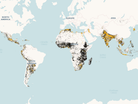IBM and UNDP Launch Free Interactive Energy Models

Energy modelling has a variety of uses, from guiding policy and investment decisions to implementing clean energy technologies.
Access to affordable, reliable energy is crucial for lifting people out of poverty and supporting countries to develop sustainably.
Equitable energy access can even enhance communities’ ability to cope with and recover from the impacts of climate change.
IBM and the United Nations Development Programme (UNDP) have launched two new models to forecast and model energy access around the world.
“Bringing together UNDP’s knowledge and global leadership in sustainable development and IBM’s breakthrough innovations in AI and hybrid cloud, we are proud to unveil solutions that demonstrate the power of technology to make a lasting, positive impact on our environment and in our communities,” says Justina Nixon-Saintil, Vice President and Chief Impact Officer at IBM.
The models, hosted on the UNDP GeoHub, are available for free to equip policymakers, journalists, communities and the general public with powerful information about energy.
Justina says: “By making innovative models freely accessible to the public, we aim to empower leaders, organisations and community members alike with the insights to make impactful energy decisions around the world."
IBM’s sustainability initiatives
IBM is present in more than 175 countries and is the largest industrial research organisation in the world.
Founded in 1911, the company is committed to achieving net zero GHG emissions by 2030.
Arvind Krishna, Chairman and Chief Executive Officer at IBM, says: “While we are proud of the progress we have made, we are mindful that advancing our environmental, social and governance goals is a continuous journey of improvement.”
The IBM Sustainability Accelerator is a social impact programme that addresses environmental threats around the world.
Each year the programme selects around five projects to scale technology and AI solutions for sustainability.
IBM and UNDP have worked together since 2022 through the IBM Sustainability Accelerator on these energy models.
IBM and UNDP’s collaboration
The energy modelling project started with a collaborative engagement through the IBM Garage, an end-to-end digital transformation model.
UNDP is active in 170 countries and territories, helping to reduce inequalities and exclusion, eradicate poverty and build resilience so countries can sustain progress.
This collaboration resulted in the enhancement of UNDP’s GeoHub with two new, innovative energy models.
GeoHub is a centralised ecosystem of geospatial data and services that supports a granular, localised and evidence-based approach to integrated policy making and development challenges.
"UNDP's innovative collaboration with IBM helps countries leverage development data and technology innovation to improve lives and protect the planet,” says Laurel Patterson, Head of the UNDP SDG Integration Team, UNDP Bureau for Policy and Programme Support.
“The solutions we've co-created provide a credible evidence base to help countries make meaningful and practical progress towards a just energy transition.
“Net-zero investment and people-centred development strategies are fundamental to accelerate the SDGs.”
The innovative models provide Electricity Access Forecasting and a Clean Energy Equity Index.
The Electricity Access Forecasting model
The Electricity Access Forecasting model uses IBM watsonx AI and IBM Cloud with an open-source machine learning library.
It provides future forecasts at scale of electricity use through 2030.
The model evaluates a set of factors including infrastructure, urbanisation, population and elevation in addition to land use data from IBM Environmental Intelligence.
It contains data from 102 countries across the Global South including in Latin America, the Middle East and Africa.
The Clean Energy Equity Index
The Clean Energy Equity Index was developed by IBM and UNDP with Stony Brook University.
It is a first-of-its-kind model that provides statistical geospatial data by combining environmental, social and economic factors with geospatial analytics.
Factors such as greenhouse gas emissions, relative wealth and education help to generate a Clean Energy Equity score from zero to one which represents the opportunities for clean energy development as well as urgency.
This model will provide data from 53 African countries.
******
Receive the next edition of ClimateTech Magazine by signing up for its newsletter.
As part of this portfolio, make sure you check out Sustainability Magazine and also sign up to our global conference series - Sustainability LIVE.
Also check out our Sister Brand, Energy Digital.
******

